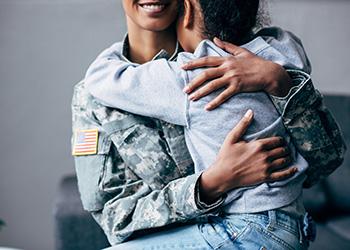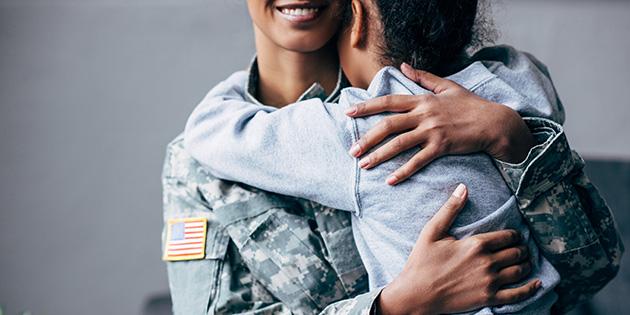
LightField Studios/Shutterstock
LeNaya Hezel is the director of the Veterans Office at Georgetown University, where she helps military-connected students access and thrive in higher education. In this month’s Higher Ed Careers interview, Hezel and Andrew Hibel discuss how attributes of the military-connected community translate to higher education, how schools can make sure they are inclusive of veterans and servicemembers, and what faculty and staff need to know to effectively serve military-connected students.
Andrew Hibel, HigherEdJobs: Mrs. Hezel, please briefly explain your student veteran population at Georgetown and some major initiatives and goals that the Veterans Office addresses?
LeNaya Hezel, Veterans Office Director, Georgetown University: Georgetown University is home to more than 1,200 servicemembers, veterans, and their families, also known as military-connected students. The military-connected student population is 6.4 percent of the overall student population. We attribute our robust military-connected population to our location in Washington, D.C., academic programs that align with meaningful career paths, and our campus community working together to foster an environment for students to thrive.
The Veterans Office provides a number of services to support military-connected students ranging from navigating higher education, career planning, and health and wellness. We offer programming throughout the year as well as one-on-one appointments to assist with military student-specific inquiries. In addition, the Veterans Office partners with colleagues on and off campus, supporting military-connected students throughout the cycle of applying, enrolling, returning, graduating, and garnering community. Our everyday mission is to implement the Jesuit spirit of cura personalis, also known as care of the whole person, into every interaction.
Hibel: There are often challenges that student veterans may face when transitioning to civilian life and in particular adjusting to life as a student. What are some of these challenges?
Hezel: From a high-level view, there are a number of challenges military-connected students face that are similar to any student. This includes adjusting to a new location, navigating a different institution, and understanding the culture of the institution. I have found that once you delve deeper into understanding the military-connected community, you will see these are students who are more likely to be older, have families, and are starting an academic program with years of professional experience. I would not call these attributes as challenges in the negative sense, but rather aspects of diversity that enrich the campus community. Military-connected students often need to connect with others who understand their experiences, and with administrators who can connect students to resources on and off campus. It is through these connections that military-connected students can better understand their attributes and experiences and use those to craft the best strategy of learning.
Hibel: What type of support, programs, or resources does Georgetown University offer to assist in overcoming these challenges?
Hezel: Following the Post-9/11 GI Bill® going into effect in 2009, Georgetown University established the Veterans Support Team (VST) that is made up of faculty, administrators, and students to formalize processes and programs ensuring a campus that is inclusive to military-connected individuals. In addition to the VST, we have four active military-connected student organizations that serve as advocates throughout our campuses in Washington, D.C.
An observation I have made is that the work to support military-connected students cannot fall solely on the Veterans Office or the team of administrators in charge of certifying students for GI Bill®® benefits. Military-connected students intersect with numerous offices and policies while pursuing their education and it requires a whole campus approach to support this population. We have found ways to collaborate, making our admissions websites inclusive, creating processes that take into account the Department of Veterans Affairs benefit timelines, and increasing scholarship opportunities.
Hibel: Do you have online student veterans as well and, if so, what are the different strategies or support systems that you employ to assist with students who may not physically be on-campus?
Hezel: Yes, 29 percent of our military-connected student population is taking classes completely online. In the last couple of years, Georgetown has expanded its online program opportunities for graduate students and I anticipate this number continuing to grow as online learning continues to evolve. Distance education students receive the weekly Veterans Office newsletter, which contains information on federal policy information, programming, and national resources pertinent to the military-connected community. We offer students the opportunity to join conference calls with our office that address questions and offer resources. In addition, we often live-stream events so that students located outside of the Washington, D.C. area can engage with the Georgetown University community.
Hibel: How are your staff and faculty trained to help student veterans and what are the top three things that staff and faculty need to know when teaching and working with veterans?
Hezel: Georgetown University implemented something called the VET Ally seminar, available to faculty, staff, and students, to provide military-connected students with a welcoming and supportive environment throughout campus. In order to create this environment, we have to start with awareness and understanding. The VET Ally seminar provides our campus with a visible network of knowledgeable supporters of service members, veterans, and military families and covers many topics of great importance to military students studying at Georgetown.
Some of the topics paint with wide brushes, so we encourage our VET Allies to continue learning about the specific issues faced by military students in higher education by attending a VET Ally 2.0 seminar, connecting with the Veterans Office, and participating in other military-connected themed programming on campus.
Participants are offered a handbook that serves as a resource to help VET Allies support the military community. VET Allies are also issued a decal to display in their office or space to highlight that the space is military-friendly.
Hibel: In addition to adjusting to civilian life, some student veterans may be dealing with emotional or physical issues such as post-traumatic stress disorder or traumatic brain injuries. Or, it may not be uncommon to see a veteran accompanied by a therapy dog. What do you think other students should know about fellow students that are veterans?
Hezel: Many types of internal injuries are not necessarily specific to servicemembers and veterans, but the difference is the circumstances of the event(s) that caused the injury. One of the biggest lessons I have learned in my work with military-connected students is that those who did not serve in the military can be impactful advocates when it comes to navigating life with an internal or external service-connected injury.
If often comes down to adjusting to a new normal and finding a voice to advocate for themselves. Service and support animals have become more common on campuses since they are common among all populations, including military-connected individuals.
Hibel: How would you describe a “veteran-friendly campus” and what do you think are at least three major points a college or university should consider in order to focus on being veteran friendly?
Hezel: I have noticed a shift in language where Universities like Georgetown have begun to use the phrase “military-connected inclusive” when describing an institution’s approach to supporting the population. It is one thing for an organization to be friendly, but it is more meaningful for an institution to be inclusive and create a sense of belonging. I hope that it is alright to break the rules a bit, but I believe that there are five focus areas for an institution to be inclusive:
- Recruiting and Admissions: Find ways for the institution have a dedicated webpage, mention, or recognition of military-connected students for admissions. Georgetown’s Veterans website for admissions questions is: https://uadmissions.georgetown.edu/applying/military-veterans/
For four-year institutions, collaborate with community colleges, veteran service organizations, and military education centers to highlight the institution as a realistic pathway of education. - Financial: Participate in the Yellow Ribbon Program in partnership with the Department of Veterans Affairs (VA). For students who are not eligible to participate in the Yellow Ribbon Program, create military-specific scholarship opportunities. Create student account policies that take into account the VA payment timelines.
- Academic: Review the American Council on Education’s Military Guide to evaluate if courses taken in the Armed Forces can transfer as academic credit. Publicize the institution’s military leave of absence policy in syllabi and establish a leave and re-enrollment checklist for students.
- Campus Culture: Support military-connected student leaders on campus in which they advocate and create a community for the population. Offer programming outside of Veterans Day and Memorial Day as a way to build bridges among the military-civilian divide. Georgetown also highlights stories of our campus Veterans online.
- Dedicated Support Services: Whether an institution has a robust or modest military-connected student population, establish administrative positions to serve as a resource for the population. Have it written in an office mission or position description to institutionalize the personnel support. Provide faculty and administrative training on how to serve as an ally to military-connected students.
Hibel: What does your campus do to recognize and bring awareness to student veterans not only on Veterans Day but throughout the year?
Hezel: Celebrating Veterans Day on campus is one of Georgetown’s signature events. The university is open on Veterans Day and we hold the ceremony on the front lawn as a way to bring together the campus community. The Georgetown University Student Veterans Association (GUSVA) works closely with the President’s Office to invite a military-connected alumnus to serve as the keynote.
A few years ago, I noticed that offices and organizations were hosting military-connected events in November, but no one was aware of the events taking place. To help recognize the military-connected students at Georgetown and highlight the events taking place around campus, we launched Military-Connected Awareness Month to list the ways the campus comes together to highlight and celebrate the military-connected community.
Georgetown also strives to promote and tell the stories of our student veterans all year round through a webpage dedicated to our student veterans.
Hibel: Georgetown has ranked high in the U.S. News and World Report rankings of “Best Colleges for Veterans” in terms of top-ranked schools that offer benefits that can help them make pursuing a college education more affordable. In what ways does Georgetown help prospective student veterans make Georgetown accessible for their education?
Hezel: I believe that Georgetown goes beyond the U.S. News and World Report’s criteria for “Best Colleges for Veterans.” While we are an institution with a robust number of military-connected students, and we participate in the Yellow Ribbon Program, these are not the only areas to focus on when reviewing schools as a military-connected student.
We have dedicated staff in the Veterans Office to address prospective and current student inquiries, faculty and staff can attend trainings to become an ally, we participate in outreach programs such as the Warrior-Scholar Project, attend and host military-connected education fairs, and have dedicated websites to highlight the pathways to our programs. It is important to attract prospective military-connected students to apply, but it is just as important to support them once they enroll and graduate.
Hibel: Mrs. Hezel, please briefly explain your background and your passion for working in higher education in Veterans Affairs.
Hezel: My partner was stationed outside of Seattle, WA when the Post-9/11 GI Bill® was signed into law. At the time, I was working in residence life, but my partner’s crewmates came to me with questions about using their benefits and pursuing higher education. I could hear the sense of frustration in their stories of navigating between the Department of Defense’s education centers and institutions of higher learning. This motivated me to bridge the two worlds, helping military-connected students see their potential and talent and using that to succeed as students. The skills of leadership, service, resiliency, and adaptability are already present, but can sometimes get lost in translation and overlooked in the bureaucracy of large organizations. My role is to shine a light on the pathways students create so that they can clearly outline and take ownership of their personal, academic, and professional achievements.
